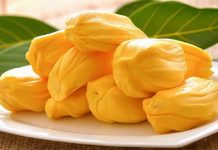Scientific name: Trichosanthes tricuspidata Lour.
Family: Cucurbitaceae
Synonym: Trichosanthes bracteata (Lam.) Voigt
Bengali/Vernacular name: Makal.
Tribal name: Mamalaru (Garo), Choim-chapray (Khumi), Caha-sthei (Rakhaing), Hedaphal (Chakma).
English name: Indrayan.
Description of the plant: A large climber, 5-20 m long. It has strong, woody and grooved stem, with trailing branches. Tendrils are divided into 2-3 parts. Leaves, 6-12 cm across, are broadly heart-shaped, but palmately 3-5 lobed. The leaf margin is toothed. Flowers occur either singly or in 5-10 flowered racemes, in leaf axils. Sepal cup is tubular, 3-4 cm long. Flowers 4-5 cm, white, with 5 wedge-shaped petals with frilly margins. Fruit is spherical, 4-5 cm across, red when ripe, streaked with 10 orange streaks.

Plant parts used: Leaf.
Ethnomedicinal uses: Pea-sized pills are made with the leaves of the plant is taken three times a day (one pill each time) for seven days to treat abdominal pain.
Leaf-paste of the plant is applied on the infected skin to treat allergy.
A fresh juice is extracted from the leaves of the plant is taken twice a day (10 ml amount each time) for seven days to treat dysmenorrhoea.
Pea-sized pills are made with the leaves of the plant is taken thrice a day (one pill each time) for two days to treat flatulence.
Paste prepared from the leaves of the plant is applied externally to treat boils, rheumatism, and snake bite.
Distribution: This species is found in Tangail, Chittagong, and the Chittagong Hill Tracts.
Is this plant misidentified? If yes, please tell us….















… [Trackback]
[…] Find More on on that Topic: natureinfo.com.bd/trichosanthes-tricuspidata/ […]